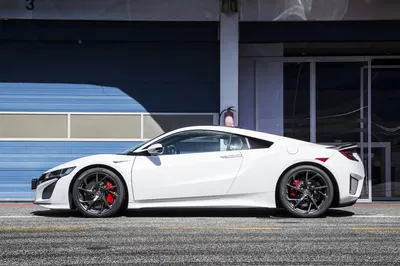7 Fascinating Technical Facts About The 2017 Honda NSX

A couple of months ago, I found myself blatting the new Honda NSX around Portugal’s Estoril circuit. When I wasn’t falling in love with the car’s ability and surprising tactility, I was being blown away by all the geeky tech stuff going on under the skin.
While our verdict on the NSX has since been delivered, it’d be remiss of me not to delve a little deeper into some of this tech. Let’s get started…
The V6 engine has a weird cylinder bank angle

V6 engines most commonly have either a 60 or 90-degree V angle. But the NSX? Its 3.5-litre lump sits at a positively weird 75-degree angle. It’s not an angle unique to the NSX’s V6 - a now defunct line of Isuzu engines were 75-degree affairs - but it is very uncommon.
It’s all about giving the engine a low centre of gravity. Sure, as anyone who understands how numbers work can tell you, 90 is a wider angle than 75. But 90-degree V6s - a layout usually found on designs derived from 90-degree V8s - have inherent vibration issues. So, 75 it is.
It’s also an engine that’s unique to NSX. Unlike early designs of the car which featured an existing Honda V6 mounted transversely, the longitudinally-mounted unit in the NSX is of a clean sheet design. It’s nowhere near as melodic as the old 3.0 litre, but give it a few years and there’ll be plenty of these cars running around with nicely shouty aftermarket exhausts.
It has the lowest centre of gravity of all current 'baby' supercars

Partly thanks to that aforementioned V6 and the fact its mounted very, very low with a compact nine-speed dual clutch gearbox, the NSX has ended up with a jolly low centre of gravity. In fact it’s the lowest in class.
The brake pedal simulates feel to unnerving effect

When first driving the new NSX at Estoril circuit, I was taken aback by just how much feel there was through the brake pedal. Particularly because it’s not really ‘feel’ at all: as the NSX operated a brake-by wire system, it’s simulated.
A feedback system using the rate of deceleration as a reference point, giving the amount of stiffness you’d be feeling with a conventional hydraulic setup. Sounds like it shouldn’t work, but trust me: it does.
The motors make it faster in a straight line, and in corners

The NSX gets a trio of electric motors. There’s a pair on the front axle - each putting out 37bhp - plus an extra one attached to the flywheel. As well as making you quicker in a straight line and providing ‘torque fill’ to give more low-end response, the hybrid setup is also intended to make you quicker round corners.
The two front motors can operate individually, apply either a positive or negative torque input. So, the torque output over the front axle can be varied where necessary, effectively nudging the nose back into line when you’re driving hard.
Sounds very much like a limited-slip differential, but an LSD can’t apply negative torque like these motors can, and an LSD only works under throttle, whereas this system will happily work off throttle. I’ll admit the one time I felt the motors guiding me when off throttle at Estoril was a little unnerving, but it saved me from embarrassingly smacking into a cone.
At the rear meanwhile, things are a little more conventional. We have conventional torque vectoring by braking system, plus a mechanical LSD.
As explained here by NSX Dynamic Project Leader Nick Robinson - a man with an exceptional intellect as well as a stunning moustache - Honda’s new supercar does some very clever things with airflow. Air is carefully directed down the sides of the cars to the intakes in front of the rear wheels, after which it flows onto out of the rear via the flying buttresses, slots in the tail lights and boot, plus the larger outlets in the lower section of the bumper.
As a result of all the trickery, the NSX gets the downforce it needs, but without the need for big, pokey-out bits of aero.
The A pillars are thin, yet super strong

This seems like an odd point to pick out, but with massive, vision-blocking A-pillars becoming ever more common in modern cars, it’s refreshing to get in the NSX to find they’re delectably thin. Thanks to the pillars and the roof side rails being all one piece and made from ‘robotically articulated, three-dimensionally bent and quenched’ ultra high-strength steel tubes (quenching is the rapid cooling of heated metal, by the way), they’re about 33mm thinner than they would have been otherwise. Good to know.
It’s way stiffer than a Ferrari 458 Italia

As well as a Porsche 991 911 GT3 and a McLaren 12C, the NSX development team bought a pair of Ferrari 458s for analysis. One of these was almost completely dissected, its sacrifice providing vital information. Thanks in part to the analysis of the Ferrari, the NSX’s multi-material space frame - made of that funky 3D quenched ultra high-strength steel, aluminium and bog steel - enjoys 300 per cent the dynamic torsional stiffness of the 458’s own space frame, and 200 per cent the static torsional stiffness. It’s the most rigid car in class, too.















Comments
Ugly wings?
Proper wings are never ugly
It is quite stunning in person!
just aks FailRace he’ll get angry if you call a big wing ugly…
Gooseneck wings work better and look better imo
Here’s a fact: The NSX is actually made by Acura. Bam! Knowledege bomb dropped on all you european commies!
That’ll teach you to not make a whole new company for one country!
I think the JDM Renaissance, if you will, has kinda lost the point. And I think more petrolheads will sign on to the new muscle bandwagon. http://www.carmrades-blog.com/articles/2016/9/27/jdm-heaven-in-a-v6-camaro.
#plugged
Its only lost point if ppl are dumb enough to not realize that hybrids and evs are the future. Whoever invests in technology for the distant future has to fork out a lot of money today. The downside is that you will have to price futuristic products way too high if you want to recover your R&D investments.
The upside is that as you pave the way, you will end up with more reliable yet affordable vehicles in the future.
Like how the Japanese sportcars were 4 cyl or 6 cyl goodness in the 90s and 2 decades later while they moved onto hybrids, the USDM manufacturers are creating 4 and 6 cyl lightweight sports cars that were once considered sacrilege by USDM fans
The real question is what is going to be next? I’m thinking European cars have whats next, with all the little hatchbacks and such.
I find it odd despite having so much tech and potential, it’s still slower than a standard 2012 Nissan GT-R R35 around the Top Gear test track. A bit awkward considering that GT-R doesn’t even have that much power compared to the NSX and weighs as much as mount Fuji. :/
VTEC didn’t kick in yo
It got beat by a Shelby GT350R at the Laguna Seca track, and the new NSX was only a little bit faster than the 2012 Nissan GT-R at the Top Gear Track
You also have to realize this is going to be a platform rather than a stand alone model. There will be faster versions to come
Here you go in case you need to travel again…..
The Autódromo do Estoril (officially, Autódromo Fernanda Pires da Silva) is a motorsport race track in Portugal, owned by state-run holding management company Parpública. Its length is 4.182 km (2.599 mi). It was the home of the Formula One Portuguese Grand Prix from 1984 to 1996. The capacity of the motorsport stadium is 45,000.[1] The circuit has FIA Grade 1 license.[2]
Their is a spelling mistake Matt Robinson it says as instead of has on the first point
After almost 900 of regretful tries, Spain finally conquered Portugal and I didn’t notice…
O Capitão Falcão trata já do assunto
You stole my profile picture!
Comment of the week right here!
Did you really just called portugal spain?
Unfortunately yes. Not sure how I managed that one!
Isn’t “has”? Or am I just stupid…?
You forgot VTEC.
Spain’s. Estoril. Circuit. Because everything southwest of france is spain, and when you go test a car at a track in a country where 99% of vehicles have a large “P” in the license plate, right next to the EU symbol, you’re clearly in Spain (and don’t tell me a car guy doesn’t notice license plates when he visits another country).
Somehow this offended me more than an LSx swapped RX7, not just because it’s my country (spain got nothing on tuga-land) but because how the f#%k can you visit a country and think you’re somewhere else!?!?
exhales
Alright, let me go read about le mighty NSX :)
You just saved me a lot of writting. I subscribe this 100%.
Certainly didn’t think I was Spain at the time, especially since I was gorging on Portuguese egg custard tarts at the time. Cannot explain why I typed Spain. Corrected now!
Pagination